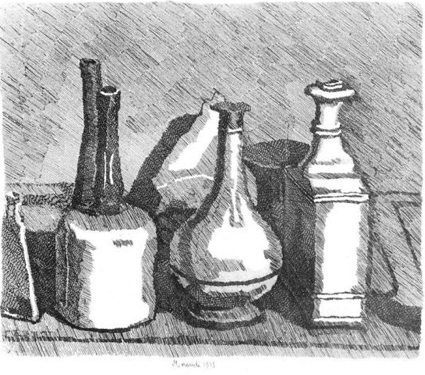“Lines of Poetry”: Giorgio Morandi, at the Estorick Collection.
Giorgio Morandi (1890-1964) was one of twentieth-century Italy’s leading artists, and a deeply reclusive man. A lifelong bachelor, he shared a modest flat in Bologna with his three sisters, Anna, Dina and Maria-Teresa. A small room with a tall white-shuttered window, overlooking a patch of scrubby garden, served as his studio. The space has been preserved as it was on the day that he died, as a kind of shrine to his memory, although it more closely resembles a monastic cell – fitting for a man whose nickname among his fellow artists was “Il Monaco”, the monk. The room contains an easel set in front of a wooden plinth, on which he used to compose his still life compositions: ever-changing configurations of vases, bottles, jugs, coffeepots, cups, funnels, shells, weathered spheres of wood, and other such bric-a-brac. The rest is taken up by his single bed, and by his hoard: a long-accumulated clutter of the mute, ordinary things he liked to paint, densely stockpiled on low tables and packing crates.
Morandi sporadically ventured into landscape but spent the majority of his life painting tabletop arrangements of his cherished objects. Despite his narrow focus, the pictures that he produced have a surprising breadth of implication and depth of feeling. Morandi used painting to ask searching philosophical questions. How does the act of seeing determine, or constrain, our knowledge of the world? How do we separate illusion from reality, when faced both by the buzzing confusion of our visual sensations, and our own emotional responses to it? His painting is made of a thousand subtle shifts and inflections, which melt the outlines of things and make the fall of light and shade seem almost palpable, so that objects seem indistinguishable from the medium...


